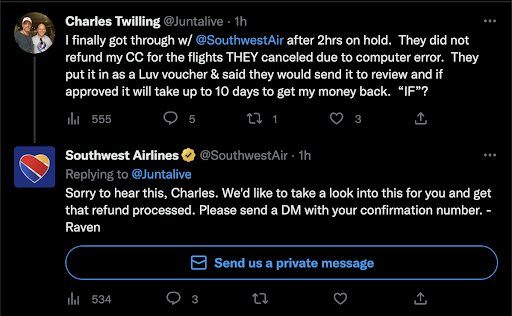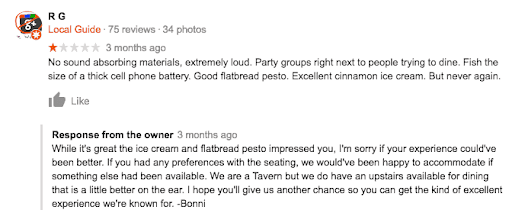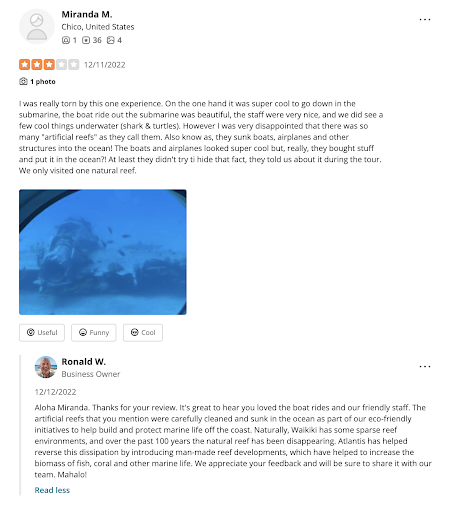8 Best examples of reputation management
Reputation management strategies can have many moving parts, but you simply can’t have an effective reputation management campaign without review management at the heart of it. Reviews and ratings have a very significant impact on consumer perceptions of a business: 86% of people say they are willing to pay more to buy from a company with more positive reviews. Review management is absolutely essential for any business that wishes to grow its customer list and its bottom line, and great examples of reputation management prove it.
The easy way to respond to online reviews. Download the review response templates right here.
Positive reviews will give any business owner or marketing manager a warm fuzzy feeling, but it’s inevitable for some negative reviews to occasionally come through as well. They might feel unfair, and they might be frustrating, but they should never be deleted. Instead, they should be seen as an opportunity to respond in a way that enhances the business’s online reputation. Leaving positive reviews unacknowledged is another way to diminish your brand’s online reputation, so it’s important to respond to reviews of all kinds in a productive, reputation-enhancing manner.
That’s exactly what we’ll show you how to do with these online reputation management examples. Read on to see our top tips for review management, each illustrated with effective brand reputation management examples from real businesses.
1. Take ownership
We’ve all seen the usual canned responses to negative reviews that tell the viewer that their feedback has been shared with the appropriate parties internally. While this is certainly better than not responding at all, it’s still an example of bad online reputation management. People will generally be able to tell if they’re receiving a generic response. As a result, they’re unlikely to believe their concerns are truly being discussed internally.
Think of the last time you were really upset or angry about a product or service you paid for. You likely felt that no one at the business took ownership of the situation or made an earnest effort to ensure your satisfaction. As this online reputation example illustrates, there is a better way.
First, the owner himself responds, offering his name and his personal apologies. He takes ownership of the customer's disappointment, acknowledging that his team did not meet the client’s expectations. Most importantly, he shares his contact information and invites the reviewer to get in touch and discuss the issue further. He doesn’t pass the buck to his staff; ultimately, the customer doesn’t care who messed up but, rather, that responsibility is taken for the fact that their expectations are unmet.
The result is a message that clearly conveys the owner is willing to take responsibility for the negative experience. It shows they stand behind their product enough to invite further discussion with the client. This example of reputation management is anything but canned. It demonstrates that a negative review can be an opportunity to demonstrate your commitment to customer satisfaction and responsibility in ensuring it is always met.
2. Time is of the essence
The sooner a review is acknowledged, the better. Responding fast gives you the opportunity to defuse the situation when the customer is most upset, so they don’t have to sit with their dissatisfaction for a long time.
This online reputation management example illustrates a response given to an upset customer right away. Note that the platform here is Twitter, so a speedy response time is likely to be expected even more than if the review were on something like Expedia.
The lesson? Apart from always aiming to respond to reviews quickly, you may want to have a strategy in place for fast-paced social media platforms where near-instant replies are the expectation.
3. Express gratitude
It may not feel as pressing to respond to positive reviews. After all, the customer is clearly happy, right? They don’t urgently need more attention.
However, as this brand reputation management example illustrates, you should say thank you and express your gratitude to the customer for taking the time to leave a review regardless of whether it is positive or negative. In fact, responding to positive reviews signals that you don’t take your customer’s business or satisfaction for granted. Any good reputation management strategy should include responding to all reviews, regardless of whether they are positive or negative, and thanking customers for their review and their business.
4. Reiterate the good
Sometimes, in the midst of a dreaded negative review, a customer might include some commentary on aspects of their interaction or transaction that they found positive. If they do, take a moment in your response to reinforce the positive aspects of their experience with your business.
There are two important reasons to do this: Firstly, it reminds the customer of what they did like about doing business with you, possibly encouraging them to view their overall experience a little bit more positively. Secondly, because there are potentially hundreds or thousands of other prospective customers who may read the review, you want to make sure that they are left with as positive an impression of your business as possible. Reminding those readers of what the reviewer did, in fact, enjoy, can help make their impression—and your client’s brand reputation—a bit rosier.
In this example of reputation management, the owner says “it’s great the ice cream and flatbread pesto impressed you,” reinforcing the fact that the dishes at their restaurant were delicious, despite the noise complaints. Their review also goes on to address the direct concern. Importantly, it also proposes a solution. Stating by reiterating the good is an excellent reputation management strategy.
5. Show your personality
This is a great point to remember, but it does have some caveats. In this example, the manager responds to the positive review with a bit of playfulness, reflecting the carefree, relaxing environment of their business. They inform the reviewer that they’ve “figured out what makes every guest happy: coffee in the morning, wine in the evening, and a friendly fish to come home to.”
This example of reputation management shows that your review responses can be a good place to use your brand voice and showcase your brand personality, which helps to reinforce your image and enhance your overall reputation.
The caveat is this: There are times when it’s important to be serious, regardless of your brand voice. You may have a goofy, lighthearted brand voice, but if a customer is unhappy, that’s not the voice they’ll want you to use when engaging with them. Professionalism and respect come first.
6. Take the conversation private
Sometimes, it will be appropriate to take your conversations to a private forum, like in this online reputation management strategy example. Here, the customer is clearly very disappointed, and they’ve listed multiple reasons why they are dissatisfied: the food, the service, the entertainment, and the cleanliness. Since there are many points that the management needs to address, this is a conversation that is best taken to a one-on-one forum, such as email or a phone call.
By inviting the customer to continue the conversation privately, you acknowledge the severity of their concerns and also create the discretion for your business to address the problems in a way that is most appropriate to the situation.
You may not want to advertise how you addressed the issues publicly, because then every customer may want the same treatment. By handling it privately, you afford yourself that discretion.
7. Think of the other readers
As we mentioned in an earlier online reputation example, many will read your review responses, not just the original reviewer.
In some cases, like this one, you can take the opportunity to address a common concern by informing and educating readers through your response. Someone reading this who might feel similarly confused about artificial reefs can learn that they are, in fact, part of an effort to increase marine biomass. This is a great online reputation management strategy example, because it shows how the business communicates its brand values—in this case, wildlife preservation—through its review responses.
8. Delight your customer
As online reputation management stats indicate, a one-star difference can increase a restaurant's annual revenue by up to 9%. That’s a very significant boost, so making the effort to bump up those reviews is worthwhile. Here, the business opts to express its thanks to customers with the surprise of a $10 gift certificate for their next visit. The friendly gesture just might help bump up this four-star review to a five-star review after the next visit.
Bonus: Tips from the best examples of reputation management
These companies with good reputation management examples provide some insight into what a great review management strategy should look like. To implement your own strategy, keep these tips in mind.
Create internal policies
Don’t leave your reputation management up to chance or the mood of your different employees. Instead, create easy-to-follow internal documents and guidelines, as well as review response templates, that ensure all customers get the same excellent treatment, no matter what.
Good reputation management plan examples include:
- guidelines for appropriate language to use
- actions to take in the event of common complaints
- training protocols for new employees
Assign responsibility
No one really wants to be responsible for an unfortunate customer experience, but it’s important to assign clear ownership for review management, including the handling of negative reviews. There should also be guidelines for the chain of command if an issue has to be elevated to someone more senior in your organization. As some of the online reputation management examples we looked at illustrate, taking ownership is always a positive.
Answer FAQs
Some review sites have FAQ sections. Be sure to monitor and respond whenever its appropriate, like this example from a hotel.
The unanswered question is specifically for guests who have attended the hotel, so it’s appropriate for the business to leave it unanswered.
Frequently asked questions
What are some example strategies for online reputation management?
Effective strategies for online reputation management include handling negative SEO signals that can damage your online reputation such as negative online articles or low-quality backlinks, responding to both positive and negative reviews, building positive buzz through collaborations with influences, local SEO initiatives such as listing building, and encouraging customers to leave reviews and share their positive experiences. All of these strategies are geared toward building, protecting, and improving your client’s online reputation.
How should you manage your online reputation?
Managing an online reputation manually is difficult, so businesses should use software. Leverage reputation management software such as Reputation Management and Customer Voice to effectively manage reviews and mentions while accurately gauging brand sentiment.











